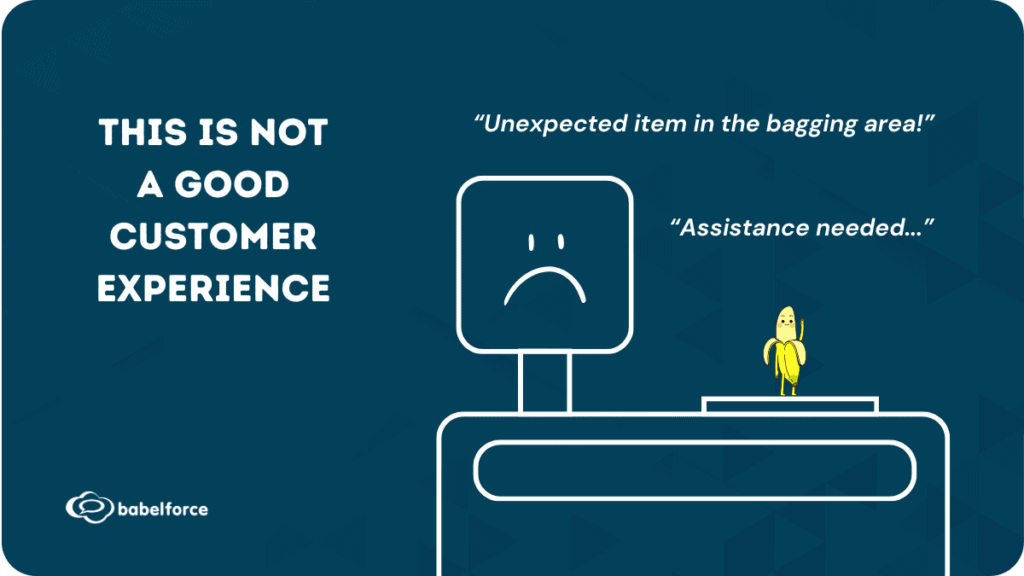A grocery chain has become the first in the UK to remove self-service checkouts from most of its stores following customer feedback.
This is the latest in a series of businesses (high-street and online) to change the way they use automation, moving away from a one size fits all approach.
Booths’ managing director – Nigel Murray – told the BBC:
“Our customers have told us this over time, that the self-scan machines that we’ve got in our stores they can be slow, they can be unreliable, they’re obviously impersonal.”
Automating and de-automating with nuance
Booths’ customers are not alone in their opinions.
Self-service checkouts haven’t had an easy time in the press, with headlines ranging from ‘Self-checkout Is a Failed Experiment’, to ‘Three cheers for the death of the supermarket self-checkout’.
It’s easy to see why. No-one likes being chastised by a machine for improper placement of a banana on a scale.
Despite that, Booths have not removed self-checkouts from all their stores.
They’ve listened to customer feedback and eliminated them from most of their stores – 26 of them – so that customers have someone to talk to. For premium chain Booths’, founded in the North of England in 1847, ‘high levels of warm personal care’ are what set the brand apart.

“We like to talk to people and we’re really proud that we’re moving largely to a place where our customers are served by people, by human beings, so rather than artificial intelligence, we’re going for actual intelligence,” says Murray.
Booths has kept self-service checkouts to help with demand in its two busiest stores, in the UK’s Lake District (which receives 18.1 million tourists per year).
“You have to know when to automate and when not to,” says Pierce Buckley, CEO of babelforce. “The goal isn’t to automate your customer service, it’s to deliver outstanding customer service. Sometimes that means human interaction, and sometimes that means self-service.”
Avoiding ‘automation for the sake of automation’
In the US, Walmart and Costco have also reduced their checkout automation, but for different reasons.
Walmart is removing self-checkouts from at least three stores according to business insider, and both Walmart and Costco are increasing human supervision of self-checkout lanes.
This may, as customers and staff have suggested, be to combat theft that results from there being ‘fewer eyes on a transaction’.
The motivations here are slightly different – but what Walmart has in common with Booths in the UK is a willingness to change the way they automate until it works for them.
In his book ‘The Overworked Consumer: Self-checkouts, Supermarkets, and the Do-It-Yourself Economy’ sociologist Christopher Andrews says that the real reason stores adopt self-checkouts is because their competitors do.
In other words, automation for the sake of automation.
Booths, Walmart and others seem to have realized that there’s no one-size-fits-all approach, and that the right combination of human service and automation will work better for some businesses than full automation.
This is happening for online businesses as well.
No annoying banana scales for online automation
Another high-end grocery business, Marley Spoon, has figured out how to make automation and human customer service play well together.
As an online retailer, Marley Spoon has an advantage – it’s easier to make the automated parts of the process unobtrusive. In fact, it’s essential because customers will be used to instant gratification in the online world.
Marley Spoon – which delivers meal-kits to homes in Europe, the USA and Australia – have been very deliberate about when to automate.
And without clunky self-checkouts in the way, it feels more personal. Kind of counterintuitive, you’d expect online shopping to be the opposite.
Automation powers the ‘digital aisles’ where customers browse and select the recipes they want. You don’t have to talk to a human to pay (it’s an online store, that would be weird.) Self-service is the norm here.
But when Marley Spoon’s customers do need to talk to a human representative, they can usually do so within 20 seconds of requesting help.
Markedly different from the long wait next to a self-service checkout while the red light flashes and the recording says ‘assistance needed’ over and over.
The human agent’s full attention gives the customer ‘someone to talk to’. And the invisible automation that connected the call makes the interaction feel all the more personal.





